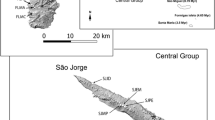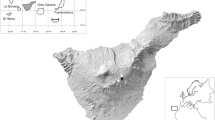Abstract
Echium hypertropicum, E. stenosiphon and E. vulcanorum are the three endemics representative of the genus Echium (Boraginaceae) in Cape Verde archipelago. The aim of this study is to provide a first attempt at estimating genetic diversity among natural populations of these endangered Echium species based on RAPD, so as to provide data available for future appropriate strategies for their conservation. PCO and UPGMA of RAPD analysis suggests a close genetic proximity between the Southern endemic species (E. hypertropicum and E. vulcanorum) and shows that the levels of polymorphism strongly differ between these two Echium species (27 and 29% respectively) and E. stenosiphon (74%), the Northern endemic species. Mantel test also corroborates a close genetic proximity between genetic and geographic data. Population genetic analysis of E. stenosiphon revealed low levels of gene flow between islands (Nm = 0.32) being S. Nicolau the most isolated as evident in PCO. Furthermore the differentiation between groups of individuals belonging to putative subspecies was tested by AMOVA. According to our results there is no genetic basis to consider the two subspecies of E. stenosiphon namely ssp. stenosiphon and ssp. lindbergii. Our results enable us to suggest that E. stenosiphon must be ranked as a Threatened species. Measures aiming at conservation of E. hypertropicum and E. vulcanorum must be implemented at short-term taking into account the small number of existing plants and its low genetic variability.
Similar content being viewed by others
References
Barrett S.C.H., Jesson L.K. and Baker A.M. (2000). The evolution and function of stylar polymorphisms in flowering plants. Annals Bot. 85: 253–265
Bauert M.R., Kalin M., Baltisberger M. and Edwards P.J. (1998). No genetic variation detected within isolated relict populations of Saxifraga cernua in the Alps using RAPD markers. Mol. Ecol. 7: 1519–1527
Böhle U.-R., Hilger H. and Martin W.F. (1996). Island colonization and evolution of the insular woody habit in Echium L. (Boraginaceae). Proc. Nat. Acad. Sci. USA 93: 11740–11745
Bramwell D. (1972). A revision of the genus Echium in Macaronesia. Lagascalia 2: 37–115
Bramwell D. (1973). Studies in the genus Echium in Macaronesia. Monogr. Biol. Canariensis 4: 71–82
Brochmann C., Rustan O.H., Lobin W. and Kilian N. (1997). The endemic vascular plants of the Cape Verde Islands. Sommerfeltia 24: 1–356
Chase M.W. and Hills H.H. (1991). Silica gel: An ideal material for field preservation of leaf samples for DNA studies. Taxon 40: 215–220
Cotrim H.C., Chase M.W. and Pais M.S. (2003). Biodiv. Conserv. 12: 1083–1098
Doyle J.J. and Doyle J.L. (1987). A rapid isolation procedure for small quantities of fresh leaf tissue. Phytochem. Bull. 19: 11–15
Esselman E.J., Crawford D.J., Brauner S., Stuessy T.F., Anderson G.J. and Silva A.M. (2000). RAPD marker diversity within and divergence among species of Dendroseris (Asteraceae: Lactuceae). Am. J. Bot. 87: 591–596
Excoffier L. (2001). Analysis of population subdivision. In: Balding, D.J., Bishop, M. and Cannings, C. (eds) Handbook of Statistical Genetics, pp 271–307. John Wiley & Sons, Chichester, UK
Excoffier L., Smouse P.E. and Quattro J.M. (1992). Analysis of molecular variance inferred from metric distances among DNA haplotypes – Application to Human Mitochondrial – DNA Restriction Data. Genetics 131: 479–491
Fischer M. and Matthies D. (1998). Am. J. Bot. 85: 811–819
Fischer M., Husi R., Prati D., Peintinger M., Kleunen M. and Schmid B. (2000). RAPD variation among and within small and large populations of the rare clonal plant Ranunculus reptans (Ranunculaceae). Am. J. Bot. 87: 1128–1137
Fu C., Qiu Y. and Kong H. (2003). RAPD analysis for genetic diversity in Changium smyrnioides (Apiaceae), an endangered plant. Bot. Bull. Acad. Sinica 44: 13–18
Gitzendanner M.A. and Soltis P.S. (2000). Patterns of genetic variation in rare and widespread plant congeners. Am. J. Bot. 87: 783–792
Gomes I., Gomes S., Kilian N., Leyens T., Lobin W. and Vera-Cruz M.T. (1995). Notes on the flora of Cape Verde Islands, W Africa. Willdenowia 25: 177–196
Holsinger K.E. and Gotlieb L.D. (1991). Conservation of rare and endangered plants: principles and prospects. In: Falk, D.A. and Holsinger, K.E. (eds) Genetics and Conservation of Rare Plants, pp 195–208. Oxford University Press, Oxford
Huenneke L.F. (1991). Ecological implications of genetic variation in plant populations. In: Falk, D.A. and Holsinger, K.E. (eds) Genetics and Conservation of Rare Plants, pp 31–44. Oxford University Press, Oxford
Karron J.D. (1991). Patterns of genetic variation and breeding systems in rare plant species. In: Falk, D.A. and Holsinger, K.E. (eds) Genetics and Conservation of Rare Plants, pp 87–98. Oxford University Press, Oxford
Kingston N., Waldren S. and Smyth N. (2004). Conservation genetics and ecology of Angiopteris chauliodonta Copel. (Marattiaceae), a critically endangered fern from Pitcairn Island, South Central Pacific Ocean. Biol. Conserv. 117: 309–319
Leyens T. 2002. Biodiversidade da prevista área protegida na Ilha do Fogo/Cabo Verde. TÖB: F-IV, Germany, pp. 91
Leyens T. and Lobin W. (1996). Primeira Lista Vermelha de Cabo Verde. Courier Forsch.-Inst. Senckenberg 193: 1–140
Lloyd D.G. and Webb C.J. (1992). The evolution of heterostyly. In: Barrett, S.C.H. (eds) Evolution and Function of Heterostyly, pp 151–178. Springer Verlag, Berlin (Germany)
Martins E.S. 1995. Flora de Cabo Verde 74. Boraginaceae. Instituto de Investigação Científica Tropical e Instituto Nacional de Investigação e Desenvolvimento Agrário – Lisboa/Praia, pp. 22
Menges E.S. (1991). The application of minimum viable population theory to plants. In: Falk, D.A. and Holsinger, K.E. (eds) Genetics and Conservation of Rare Plants, pp 45–61. Oxford University Press, Oxford
Olesen J.M. (1979). Floral morphology and pollen flow in the heterostylous species Pulmonaria obscura Dumort (Boraginaceae). New Phytol. 82: 757–767
Parker P.G., Snow A.A., Schug M.D., Booton B.C. and Fuerst P.A. (1998). What molecules can tell us about populations: choosing and using a molecular marker. Ecology 79: 361–382
Peakall R. and Smouse P.E. (2001). GenAlEx V5: Genetic Analysis in Excel. Population genetic software for teaching and research. Australian National University, Camberra, Australia.http://www.anu.edu.au/BoZo/GenAlEx/.
Petterson B. (1960). Notes on a collection of vascular plants from Cape Verde Islands. Commentationes Biologicae 22: 1–68
Philipp M. and Schou O. (1981). An unusual heteromorphic incompatibility system: distyly, self-incompatibility, pollen load and fecundity in Anchusa officinalis (Boraginaceae). New Phytol. 89: 693–703
Rabinowitz D. (1981). Seven forms of rarity. In: Synge, H. (eds) The Biological Aspects of Rare Plant Conservation, pp 205–217. John Wiley & Sons, Chichester, UK
Retief E. and Wyk A. V. (1998). The genus Echium (Boraginaceae) in southern Africa. Bothalia 28: 167–177
Rohlf F.J. (1998). NTSYS-pc. Numerical taxonomy and multivariate analysis systemversion 2.0. Exeter Software, New York, New York, USA
Romeiras M.M. (2005). Caracterização molecular e conservação de três espécies de Echium (E. hypertropicum, E. stenosiphone E. vulcanorum) endémicas em Cabo Verde. PhD thesis, Faculty of Sciences of the University of Lisbon, Portugal
Schneider S., Roessli D. and Excoffier L. (2000). Arlequin ver. 2.000: A software for population genetic data analysis. Genetics and Biometry Laboratory, University of Geneva, Switzerland
Schneller J.J. and Holderegger R. (1996). Genetic variation in small, isolated fern populations. J. Veget. Sci. 7: 113–120
Sunding P. (1973). Endemism in the Flora of the Cape Verde Islands, with special emphasis on the Macaronesian flora element. Monographie Biologicae Canarienses 4: 112–117
Thioulouse J., Chessel D., Dolédec S. and Olivier J.M. (1997). ADE-4: a multivariate analysis and graphical display software. Stat. Comput. 7: 75–83
Wang Z.S.A., Liu S.Q., Leng H., Zheng L. and Liu J.W. (2005). Genetic structure of the endangered plant Neolitsea sericea (Lauraceae) from the Zhoushan archipelago using RAPD markers. Annals Bot. 95: 305–313
Williams J.G.K., Kubelik A.R., Livak K.J., Rafalski J.A. and Tingey S.V. (1990). DNA polymorphisms amplified by arbitrary primers are useful as genetic markers. Nucleic Acids Res. 18: 6531–6535
Yu K. and Pauls K.P. (1992). Optimisation of the PCR program for RAPD analysis. Nucleic Acids Res. 20: 2606
Zawko G., Krauss S.L., Dixon K.W. and Sivasithamparam K. (2001). Conservation genetics of the rare and endangered Leucopogon obtectus (Ericaceae). Mol. Ecol. 10: 2389–2396
Author information
Authors and Affiliations
Corresponding author
Rights and permissions
About this article
Cite this article
Romeiras, M.M., Cotrim, H.C., Duarte, M.C. et al. Genetic diversity of three endangered species of Echium L. (Boraginaceae) endemic to Cape Verde Islands. Biodivers Conserv 16, 547–566 (2007). https://doi.org/10.1007/s10531-006-6734-0
Received:
Accepted:
Published:
Issue Date:
DOI: https://doi.org/10.1007/s10531-006-6734-0




